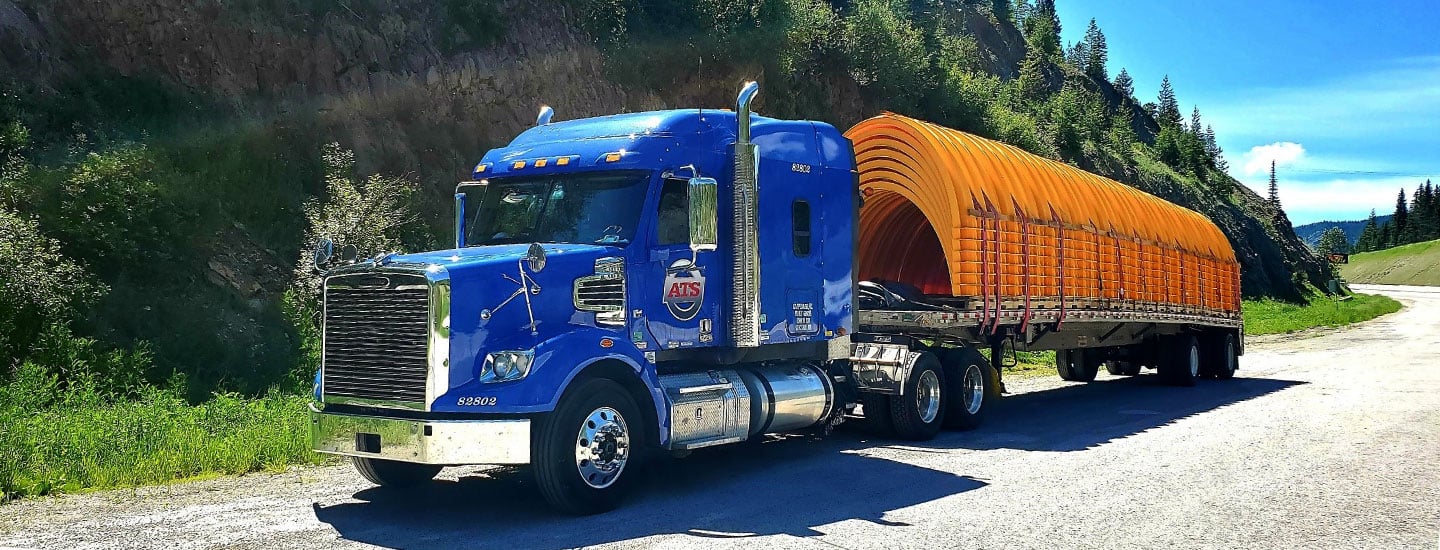Independent Contractor | Company Driver | Flatbed Driver | Heavy Haul Driver | Owner-operator
ATS Flatbed Program: Everything You Need to Know
Robbie came to ATS with ten years of transportation experience under his belt. He has worked at ATS for the last seven years as a driver consultant. He prides himself on using his industry knowledge to assist drivers in making the best decisions for themselves.
For the right kind of driver, flatbed offers challenge, variety, and real earning power. But if you’ve ever looked at a loaded step-deck and thought, “I’d love to learn how to handle that,” you’ve probably also wondered: Where do I even start?
Anderson Trucking Service (ATS) has spent decades building a flatbed program that supports drivers at every stage — whether you’re brand-new to flatbed or have years of experience under your belt.
While over-the-road (OTR) experience is important, we’re most interested in your attitude. If you’re excited by the idea of hauling big, heavy, high-value freight — and willing to put in the work to do it right — we’ll get you trained, equipped, and earning confidently.
In this blog, we’ll break down the freight you’ll haul, the equipment you’ll use, what the pay and home time look like, and the pros and cons to keep in mind before joining the flatbed ranks.
Whether you’re exploring your next move or have long dreamed of a future in heavy haul, the ATS flatbed program offers a proven path forward — and a company that’ll have your back along the way. Let’s get into it.
Driver Experience and Training Requirements
The ATS flatbed program does require some experience: a minimum of six months of OTR flatbed experience, or one consecutive year of OTR experience within the last three years.
That said, the ideal candidate isn’t just someone with time behind the wheel — it’s someone who’s motivated to grow their skillset and is genuinely excited by what flatbed offers.
So, never pulled a flatbed before? That’s fine. If you’ve got the drive, we’ll meet you with the training. ATS’s training program is open to all levels of flatbed experience — including none, AKA “Class Zero” — and is structured to provide a clear path to Class 4 and beyond.
During training, you’ll receive classroom instruction on DOT regulations, securement types (direct and indirect), company-specific securement procedures, safety basics, and compliance best practices.
You’ll also get hands-on experience with securement techniques, chaining, strapping, tarping, removable gooseneck (RGN) trailer attachment and detachment, and more.
Perhaps most importantly, you’ll get to work on real loads. You’ll practice skills like strapping and tarping with an instructor on-hand to inspect your work, providing plenty of opportunities to ask questions and ensure you’re performing each task correctly.
We train our drivers through repetition, not pressure. Our aim isn’t to push you out onto the road as quickly as possible, but to help you develop skills at your pace.
Feel like you need more training? No problem. We’ll continue to provide more hands-on time, more step-by-step instruction, and more support until you’re completely confident in your ability to haul and secure flatbed safely.
To learn more about ATS’s flatbed securement training, check out our What to Expect video, which includes a day-by-day breakdown of the course.
What You’ll Haul: Freight and Equipment Types
This is where flatbed gets fun. At ATS, we don’t do much “sticks and bricks” freight. Instead, much of our flatbed freight is large, high-value machinery: think bulldozers, cranes, excavators, Genie lifts, agricultural tractors, oversized HVAC units, and other equipment that requires precision and respect to move.
ATS runs flatbed, step-deck, and RGN trailers. Our fleet composition is mostly Freightliners and Peterbilts, with a few Volvos in the mix.
Company drivers are assigned a truck, but if you’ve got a preference, let your recruiter know — we’ll try to accommodate when we can.
Lease drivers get to choose a truck from a selection of those prepped and ready at the time of their orientation.
When it comes to securement equipment, company drivers are fully outfitted with everything they need: chains, straps, tarps, dunnage, you name it. Lease drivers and independent contractors can purchase equipment at orientation, choosing from new or used gear.
ATS finances equipment packages at $0.04 per mile, and once you’ve paid it off, it’s yours. If you ever decide to move on, you can sell it back to us or take it with you.
Pay and Home Time
Flatbed takes a little more effort, but it pays off. ATS company drivers earn a minimum of $0.60 per mile, and they’re paid 26% of the load revenue, depending on which is higher. That means you’re never earning less than the baseline — and often taking home more.
Company drivers are typically out for two to three weeks at a time and get a day and a half off for every week they’re out. While it’s not a “home every weekend” program, you won’t be out for five or six weeks straight unless you choose to run that hard.
For lease drivers, it’s 70% of the linehaul, and because most of our freight is direct customer freight — not spot market loads — they enjoy a more stable income stream.
To learn more about our pay structure and view up-to-date pay averages, our Pay page will be your best resource outside of talking to a recruiter.
Lease drivers also benefit from:
- All permits handled by ATS
- A percentage of the fuel surcharge passed directly onto the driver
- EFS fuel card with discounts at all major truck stop chains
- Driver app that displays up-to-date fuel discounts by location
Those fuel savings alone can make a serious impact on your take-home pay. Combine that with a steady stream of consistent freight, and it’s easy to see why so many of our drivers stick around.

Pros and Cons
No matter what company you’re considering for flatbed, it’s important to understand the pros and cons of the program.
At ATS, we believe in giving prospects honest, transparent, and un-biased information so they can make the best decision for themselves. This practice helps ensure we only onboard drivers that have self-selected into the program based on a complete understanding of what it offers.
So, in that spirit, here’s a quick rundown of the pros and cons of the ATS flatbed program:
Cons
To be frank, many of the cons aren’t ATS-specific, but rather speak to running flatbed in general. Why? Because flatbed is a different beast than running dry vans, and that means it has its own unique work requirements and considerations. It’s not for everyone — and that’s okay.
While we believe our flatbed program is among the best of the best, you should be clear-eyed about these cons before signing on:
- More physical work than van or reefer freight
- Requires load securement in all kinds of weather, including extreme cold and heat, high winds, rain, snow, etc.
- Tighter delivery windows (Flatbed typically sticks to 9-to-5)
- Securement requires consistent double-checking to maintain safety.
- While ATS provides a clear path to heavy haul driving, it doesn’t happen overnight. We’ve found that most drivers take about three years to move from standard flatbed to running a true heavy haul setup with multi-axle trailers.
Pros
With all that said, if you like being active, working with your hands, and taking real pride in every load you secure, the pros are tough to beat:
- Excellent pay package and fuel benefits
- A strong training program that supports long-term growth
- Access to high-value, stable customer freight
- A financially stable company that has been family owned and operated for 70 years
- A clear path from beginner flats to oversize and beyond, all in one place.
A final note on ATS’s program: We’ve been running flatbed since our inception in 1955 — it’s literally what we were built on. We are true flatbed experts, and we’re excited by the opportunity to onboard and train the next generation.
Take it from us: If you have no flatbed experience but are eager to learn and level up your abilities, don’t hesitate to apply. We’ll not only train you on flatbed, but provide the stability and structure you need to stay with a single company as you diversify your skill set.
If your ultimate goal is to haul the biggest, heaviest, most unique freight, ATS can help you get there — and we’re pretty proud of that “pro.”

Ready to Roll? Here’s Your Next Step
If you’ve read this far, you know flatbed isn’t just another driving job — it’s a strategic move with real growth potential.
From the variety of freight and equipment you’ll handle to the thorough, hands-on training that meets you where you are, the ATS flatbed program is built to develop drivers who take pride in their craft.
We’ve covered everything from experience requirements and securement training to pay structures, home time, and the realities of life on the flatbed side of the road. Why? Because we believe informed drivers make the best long-term decisions — for themselves and their work.
If you’re ready to take the next step, ATS is ready for you. Fill out our quick application and see where flatbed can take you.


